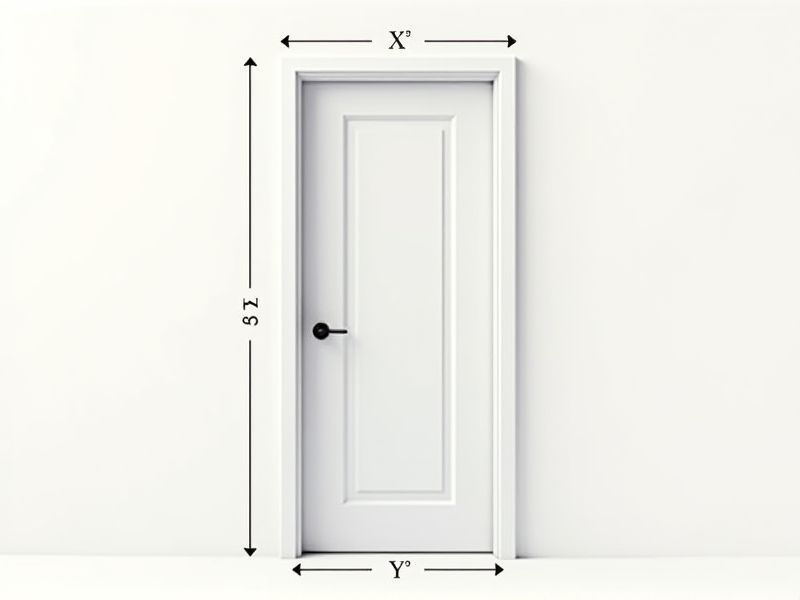
The standard dimensions for a bathroom door typically range from 28 to 32 inches in width and 80 inches in height. A common size found in many homes is 30 inches wide by 80 inches tall, which provides enough space for comfortable entry while maintaining privacy. It's important to check your local building codes, as some areas require doors to be at least 32 inches wide to accommodate accessibility needs. When selecting a door size, also consider the space available in your bathroom for easy and unobstructed use.
Width
The standard width for a bathroom door typically ranges from 24 to 36 inches, with 30 inches being the most common size for accessibility. A door width of 32 inches is ideal for accommodating larger items, like wheelchairs or mobility aids, ensuring a comfortable passage. When considering renovations or installations, you should measure the space to allow for standard framing, which is generally around 2x4 inches on each side. Proper door width not only enhances functionality but also improves the aesthetic flow of your bathroom.
Height
The standard height for a bathroom door is typically 80 inches, which is equivalent to 6 feet 8 inches. This height ensures ample clearance for most individuals, providing ease of access while maintaining privacy. For more compact spaces, customizable options might reduce the height to around 78 inches, yet this is less common. It's essential to consider your specific needs and any potential mobility requirements when selecting the appropriate door height for your bathroom.
Thickness
The ideal thickness for a bathroom door typically ranges between 1-3/8 inches to 1-3/4 inches. A thicker door not only enhances privacy but also improves sound insulation, making your bathroom experience more tranquil. Standard hollow-core doors, often used in residential settings, usually measure around 1-3/8 inches thick, while solid-core doors, offering better durability and insulation, are generally 1-3/4 inches thick. Investing in the right thickness can significantly elevate your bathroom's aesthetic and functionality.
Swing Direction
When selecting a bathroom door, the swing direction is crucial for optimizing space and accessibility. A right-hand swing door opens towards the right, while a left-hand swing door opens to the left, impacting room layout and flow. It's essential to consider the door's location in relation to fixtures like toilets and sinks; the standard bathroom door width is typically 24 to 36 inches, ensuring adequate passage for individuals, including those with mobility aids. Ensure your door swing aligns with your bathroom's overall design and functional requirements to enhance convenience and usability.
Clearance
The standard clearance for bathroom doors typically ranges from 1 to 2 inches above the finished floor. This space ensures adequate ventilation while preventing moisture build-up, which can lead to mold growth. A door with a standard height of 80 inches allows for proper accessibility and compliance with building codes. When installing, consider the importance of both aesthetic appeal and functional clearance to enhance the overall bathroom experience.
Accessibility Compliance
Bathroom door standards emphasize Accessibility compliance to ensure all individuals can use facilities comfortably. The minimum width for a bathroom door should be 32 inches to accommodate wheelchairs and other mobility aids, while a clear opening of at least 36 inches is ideal. Lever or push-type handles are recommended, as they require less force to operate than traditional knobs, increasing usability for those with limited hand strength. Additionally, doors should swing outward or be sliding types to prevent blockage in case of emergencies, enhancing safety for users.
Material
The standard materials for bathroom doors typically include solid wood, engineered wood, fiberglass, and metal, each offering unique advantages. Solid wood, for example, provides excellent durability and aesthetic appeal, with popular species such as oak and maple. Engineered wood or composite materials often provide moisture resistance, making them suitable for humid environments, while fiberglass doors are known for their robustness and low maintenance. If you prefer a more modern look, metal options like stainless steel can provide a sleek appearance and enhanced security, with various finishes available to match your decor.
Framing
The standard framing for a bathroom door typically requires a rough opening size of 32 inches wide by 80 inches tall, accommodating most residential doors. This framing often employs a 2x4 lumber configuration to ensure durability and stability, especially in the humid bathroom environment. Proper installation should maintain a level and plumb alignment to prevent future complications such as misalignment and water damage. For added moisture resistance, consider using treated lumber or a composite material in the framing process.
Lock Type
When selecting a bathroom door, consider the lock type for both security and privacy. The most common options include privacy locks, which typically feature a simple turn-button mechanism, and more sophisticated keypad locks that enhance access control. For residential settings, a single-cylinder deadbolt provides an extra layer of security, while a keyless entry lock offers convenience. Ensuring your lock meets the American National Standards Institute (ANSI) grade standards can significantly impact safety and reliability.
Handle Type
When selecting a bathroom door, the handle type plays a crucial role in functionality and aesthetics. Lever handles, often preferred for their ease of use, are ideal for busy households, allowing quick access without the need for gripping. In contrast, privacy knobs, which typically feature a push-button lock, provide a higher level of security and seclusion for bath spaces. Choosing between these options can enhance both the practicality and style of your bathroom, ensuring it meets your specific needs.
